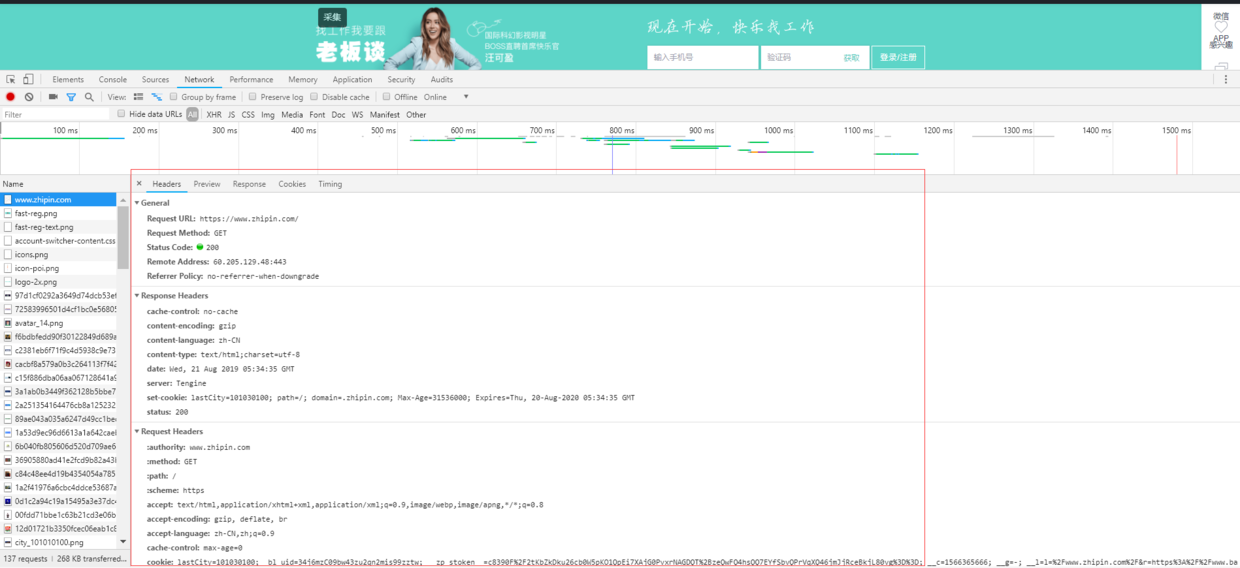Preface
Review: Basic usage of Okhttp Okhttp3 Source Parsing (1)-OkHttpClient Analysis Okhttp3 Source Parsing (2)-Request Analysis Okhttp3 Source Parsing (3)-Call Analysis (Overall Process) Okhttp3 Source Parsing (4) - Interceptor and Design Mode Okhttp3 Source Parsing (5) - Interceptor RetryAndFollowUpInterceptor

Today, when we talk about BridgeInterceptor, let's first look at the source code's explanation of this type:
/** * Bridges from application code to network code. First it builds a network request from a user * request. Then it proceeds to call the network. Finally it builds a user response from the network * response. */
It means a bridge from application code to network code
- It builds network requests from user requests
- Then make a network request
- Transfer the returned response data to the response available to the user
The BridgeInterceptor code is pasted below:
public final class BridgeInterceptor implements Interceptor { private final CookieJar cookieJar; public BridgeInterceptor(CookieJar cookieJar) { this.cookieJar = cookieJar; } @Override public Response intercept(Chain chain) throws IOException { Request userRequest = chain.request(); Request.Builder requestBuilder = userRequest.newBuilder(); RequestBody body = userRequest.body(); if (body != null) { MediaType contentType = body.contentType(); if (contentType != null) { requestBuilder.header("Content-Type", contentType.toString()); } long contentLength = body.contentLength(); if (contentLength != -1) { requestBuilder.header("Content-Length", Long.toString(contentLength)); requestBuilder.removeHeader("Transfer-Encoding"); } else { requestBuilder.header("Transfer-Encoding", "chunked"); requestBuilder.removeHeader("Content-Length"); } } if (userRequest.header("Host") == null) { requestBuilder.header("Host", hostHeader(userRequest.url(), false)); } if (userRequest.header("Connection") == null) { requestBuilder.header("Connection", "Keep-Alive"); } // If we add an "Accept-Encoding: gzip" header field we're responsible for also decompressing // the transfer stream. boolean transparentGzip = false; if (userRequest.header("Accept-Encoding") == null && userRequest.header("Range") == null) { transparentGzip = true; requestBuilder.header("Accept-Encoding", "gzip"); } List<Cookie> cookies = cookieJar.loadForRequest(userRequest.url()); if (!cookies.isEmpty()) { requestBuilder.header("Cookie", cookieHeader(cookies)); } if (userRequest.header("User-Agent") == null) { requestBuilder.header("User-Agent", Version.userAgent()); } Response networkResponse = chain.proceed(requestBuilder.build()); HttpHeaders.receiveHeaders(cookieJar, userRequest.url(), networkResponse.headers()); Response.Builder responseBuilder = networkResponse.newBuilder() .request(userRequest); if (transparentGzip && "gzip".equalsIgnoreCase(networkResponse.header("Content-Encoding")) && HttpHeaders.hasBody(networkResponse)) { GzipSource responseBody = new GzipSource(networkResponse.body().source()); Headers strippedHeaders = networkResponse.headers().newBuilder() .removeAll("Content-Encoding") .removeAll("Content-Length") .build(); responseBuilder.headers(strippedHeaders); String contentType = networkResponse.header("Content-Type"); responseBuilder.body(new RealResponseBody(contentType, -1L, Okio.buffer(responseBody))); } return responseBuilder.build(); } /** Returns a 'Cookie' HTTP request header with all cookies, like {@code a=b; c=d}. */ private String cookieHeader(List<Cookie> cookies) { StringBuilder cookieHeader = new StringBuilder(); for (int i = 0, size = cookies.size(); i < size; i++) { if (i > 0) { cookieHeader.append("; "); } Cookie cookie = cookies.get(i); cookieHeader.append(cookie.name()).append('=').append(cookie.value()); } return cookieHeader.toString(); } }
The cookieJar is also instantiated in the BridgeInterceptor initialization method, and the cookieJar code is as follows:
public interface CookieJar { /** A cookie jar that never accepts any cookies. */ CookieJar NO_COOKIES = new CookieJar() { @Override public void saveFromResponse(HttpUrl url, List<Cookie> cookies) { } @Override public List<Cookie> loadForRequest(HttpUrl url) { return Collections.emptyList(); } }; /** * Saves {@code cookies} from an HTTP response to this store according to this jar's policy. * * <p>Note that this method may be called a second time for a single HTTP response if the response * includes a trailer. For this obscure HTTP feature, {@code cookies} contains only the trailer's * cookies. */ void saveFromResponse(HttpUrl url, List<Cookie> cookies); /** * Load cookies from the jar for an HTTP request to {@code url}. This method returns a possibly * empty list of cookies for the network request. * * <p>Simple implementations will return the accepted cookies that have not yet expired and that * {@linkplain Cookie#matches match} {@code url}. */ List<Cookie> loadForRequest(HttpUrl url); }
Discovering a cookieJar is an interface with two methods:
- Save FromResponse Customizes Storing Cookies
- loadForRequest Gets the cookie for the specified URL
There are things we need to configure when requesting, such as header s, and so on, such as the following:

Is that understandable?Let's continue with the BridgeInterceptor source code: So the first step for BridgeInterceptor is to configure rquest with a header, etc. The main emphasis is:
List<Cookie> cookies = cookieJar.loadForRequest(userRequest.url()); if (!cookies.isEmpty()) { requestBuilder.header("Cookie", cookieHeader(cookies)); }
We can call loadForRequest to get our custom cookie and set it in the header. After setup, make network requests:
Response networkResponse = chain.proceed(requestBuilder.build());
Familiar with it, let's not talk about it here. Finally, the networkResponse that will be returned is the response available to the user, which needs to be noted here: 1. Receive header information and store cookie s:
HttpHeaders.receiveHeaders(cookieJar, userRequest.url(), networkResponse.headers());
public static void receiveHeaders(CookieJar cookieJar, HttpUrl url, Headers headers) { if (cookieJar == CookieJar.NO_COOKIES) return; List<Cookie> cookies = Cookie.parseAll(url, headers); if (cookies.isEmpty()) return; cookieJar.saveFromResponse(url, cookies); }
gzip decompression If the networkResponse returned by the server is compressed, it needs to be decompressed by GzipSource to read the response
if (transparentGzip && "gzip".equalsIgnoreCase(networkResponse.header("Content-Encoding")) && HttpHeaders.hasBody(networkResponse)) { GzipSource responseBody = new GzipSource(networkResponse.body().source()); Headers strippedHeaders = networkResponse.headers().newBuilder() .removeAll("Content-Encoding") .removeAll("Content-Length") .build(); responseBuilder.headers(strippedHeaders); String contentType = networkResponse.header("Content-Type"); responseBuilder.body(new RealResponseBody(contentType, -1L, Okio.buffer(responseBody))); }
That's all in this section. I hope it will help you all...

You can pay attention to my WeChat public number: "Commander Qin" is a public number with quality and attitude!
